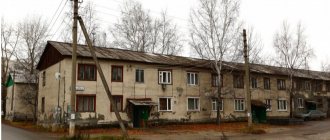According to the data available to the Ministry of Construction of the Russian Federation, at the end of 2019 in our country there were more than 54 thousand multi-apartment residential buildings that were recognized as dangerous for living in them. According to rough estimates, this is about 16 million square meters of living space, where hundreds of thousands of citizens live.
Emergency housing is not only characterized, as a rule, by the lack of necessary communications and a low level of comfort for life, but also by a significant danger for residents, since the breakdown of the house implies colossal wear and tear on the main structural elements of the building.
In this regard, federal and regional authorities are carrying out systematic legislative and practical work to quickly resettle emergency housing and reduce their share in the housing stock.
The legislative framework
Issues related to the resettlement of unsuitable housing are very complex from the point of view of organizing this process on a national scale. In this regard, their legal regulation should be comprehensive, considering both the intricacies of their financial support and the procedural procedure for carrying out the relevant work on the ground.
So, the main legal document that regulates the process of resettlement of emergency housing in terms of raising financial resources for these purposes is the federal law “On the Fund for Assistance to the Reform of Housing and Communal Services” No. 185-FZ , which was adopted back in 2007.
In accordance with this legal act, a special state fund was created, the task of which is to accumulate budget funds to resolve issues related to the overhaul of residential buildings and the resettlement of apartment buildings that are recognized as unsafe. This legal document determines the procedure for financing various targeted programs, both federal and regional, which are aimed at eliminating uninhabitable apartment buildings.
In addition, the housing rights of citizens during resettlement are established by the norms of the Housing Code of the Russian Federation. In particular, it has been established that residents of buildings and structures seized for demolition must receive residential premises of similar size. And if the tenant was the owner, then in this case he has the right to choose whether to receive a new apartment or count on adequate monetary compensation.
Issues directly related to the procedure for declaring a building unsuitable for further residence, including the corresponding procedure and timing of resettlement, are considered by a special Regulation approved by Decree of the Government of the Russian Federation No. 47 of January 28, 2006.
Reference! Existing resettlement programs, developed taking into account the designated legal acts, apply exclusively to residents of multi-apartment residential buildings.
Citizens who live in individual houses bear the burden of maintaining it exclusively at their own expense. In addition to the legal acts presented above, there are a large number of other regulatory, technical and methodological documents that affect certain aspects related to the resettlement of emergency housing.
When will the problem of emergency housing be resolved?
Sokhranov notes: the problem will remain acute for a long time, since houses built during mass industrial development in the 1960–1970s have reached the end of their useful life. Other experts also speak about a gradual increase in the number of unsafe houses.
No need for nothing: why contractors are not interested in major repairs
More than half of the tenders in 2021 failed
“The current program for the volume of emergency housing will not cope, although every year we are reported about millions of square meters that were used for the relocation of emergency housing,” Andrei Shirokov, chairman of the Chamber of Commerce and Industry Committee on Entrepreneurship in the Housing and Public Utilities Sector, told Izvestia. — Our emergency housing is increasing from year to year - approximately 0.4% of existing housing.
Nadezhda Kosareva notes that almost 2 million square meters are recognized as unsafe every year. m of housing. Moreover, she notes, in addition to this program, there are many other social obligations of the state to people to improve their living conditions.
“Currently, more than 2 million families are on the waiting list for improved housing conditions, and if we include all programs, including emergency housing, then there are already about 4 million families,” she says. — If all these obligations are fulfilled by providing apartments for ownership or under a social tenancy agreement with the right of privatization, almost 9 trillion rubles will be needed. It is clear that it is impossible to cope with this task in the foreseeable future.
Sokhranov notes: the current resettlement program alone cannot solve this problem; new additional tools will have to be developed in the near future.
Endless moving
Photo: RIA Novosti/Mikhail Voskresensky
“They are already being proposed: this includes the introduction of tools for integrated development of territories, and an increase in the share of rental housing, including those provided at a subsidized rental rate, and the development of tools for targeted assistance to citizens in need,” he said.
State resettlement programs
To quickly resolve issues related to the modernization of the housing stock in the Russian Federation, a special federal project was developed with a validity period until 2025, which involves a significant increase in funding for the regions in terms of relocating citizens from emergency apartments.
At the same time, funds are sent to the constituent entities of the federation on the basis of special programs. The procedure for their formation is determined by Article 16 of Federal Law No. 185-FZ.
In particular, it has been established that the use of federal funds is the responsibility of the regions. The necessary financing is carried out, in fact, at the request of the constituent entities of the federation, called the “regional targeted program for the resettlement of citizens from emergency housing stock.”
This document is formed and approved by the administration of the subject of the federation and must contain, among other things, the following:
- list of apartment buildings (with addresses);
- the timing of the resettlement of citizens from the specified apartment buildings into new comfortable houses;
- the amount of federal funding required, as well as available funds allocated for these purposes by the regional budget, as well as other sources;
- justification of the need to attract federal funds.
Important! The national resettlement program involves, for the most part, shared financing - both from the federal and regional (local) budgets.
Information regarding regional programs is not confidential and is available for study on the websites of local authorities of a particular region of the Russian Federation. In addition, you can get up-to-date information about the number of apartment buildings subject to demolition, plans for the inclusion of one or another apartment building in the program, as well as about houses already occupied on the Housing and Communal Services Reform website, located at the web address: https://www.reformagkh .ru.
Why do people complain about the resettlement program?
Ignore: residents of demolished houses will not pay for major repairs
This provision appeared in the bill on integrated development of territories adopted in the third reading.
Nadezhda Kosareva notes that a special commission in the municipality is responsible for recognizing an apartment building as unsafe and, on the one hand, local authorities are not always interested in the appearance of a new unsafe building.
“On the other hand, when using funds from the Housing and Communal Services Fund, there is at least an opportunity to solve this problem, which municipalities are, of course, interested in,” she says. — We have previously raised the issue of insufficient control over the decisions of municipalities: the procedure established by the government is not always followed, an independent expert assessment of wear and tear is not carried out, or is carried out by uncertified experts. But the Housing and Communal Services Fund is now dealing with these problems.
The Fund for Assistance to Housing and Utilities Reform told Izvestia that the Fund is not currently vested with the authority to control these decisions of municipalities.
“However, the Foundation carries out systematic work to monitor compliance with the procedure for recognizing residential apartment buildings as unsafe, as provided for by law,” the Foundation notes. — The results of this work are provided to the relevant executive authorities of the constituent entities of the Russian Federation and the municipalities themselves, along with recommendations for eliminating significant violations, if any are discovered during monitoring.
Also, the Foundation points out, work is underway to provide methodological support for the process of recognizing houses as unsafe - for example, in the summer of 2020, a set of rules for examining the technical condition of residential buildings was put into effect.
Chairman of the "Supports of Russia" committee for construction Dmitry Kotrovsky explains: as soon as a house acquires the status of an emergency, the administration of the locality is already legally responsible for everything that can happen to people in these houses.
“And as soon as you assign this status, you are obliged to budget all the necessary funds for relocating people to new housing,” he told Izvestia. — Including ensuring the preparation of sites for the demolition of this housing and the construction of new housing. However, I think this is not a question of the availability of funds, but more a question of administrative resources - everything needs to be done in a timely manner, constantly ensuring that the number of emergency facilities is at some minimum acceptable level.
Endless moving
Photo: Global Look Press/Komsomolskaya Pravda
Kotrovsky considers the task administrative, because “the volume of square meters that is being built in the Russian Federation is absolutely capable of covering the needs of people living in dilapidated houses.”
Echo of Tulun: it will become easier to recognize housing as unfit for habitation in the event of an emergency
The mechanism was revised after last year's flood in the Irkutsk region
Sergei Sokhranov notes other negative trends associated with the implementation of programs for relocating citizens from dilapidated housing.
“First of all, they are due to the fact that the regions now prefer not to build new houses, but to buy apartments on the secondary market,” he says. — Considering that for each subject there are established maximum prices for how much a square meter of housing can cost, apartments are also bought in houses that are far from new and better. There are cases when municipal authorities offered displaced people apartments in houses built in the 1950s, 1960s and even 1930s.
However, he notes, citizens are also wrong when they refuse to move from a dilapidated house to provided housing in another area. Residents may not like the house or the social infrastructure, but they often have no choice, says Sokhranov.
“The municipality simply does not have enough housing stock to provide a wide choice for relocation,” he said. “Let’s not forget that the main goal of the program is to eliminate the threat to the life and health of citizens posed by a dilapidated house, and not to improve their living conditions.
Criteria for dilapidation and disrepair of housing
The concept of “emergency housing” is disclosed in the relevant Regulations approved by Decree of the Government of the Russian Federation on January 28, 2006 No. 47.
Among other things, this document contains criteria by which an apartment building can be recognized as an emergency.
- Physical wear and tear and impossibility of reconstruction. All erected structures and buildings wear out over time and lose their operational properties. However, physical wear and tear in itself is not a criterion for recognizing a house as unsafe as such. An apartment building unsuitable for living has significant wear and tear on the floors, foundations and load-bearing walls, combined with the impossibility of carrying out restoration work.
- Damage to a home as a result of a man-made or natural event. If a residential building was damaged as a result of a natural emergency or an explosion, fire, or collapse, a special commission evaluates the possibility of carrying out restoration work. If the latter are impractical, then the apartment building is considered unsafe and subject to demolition.
A house may be considered unsafe even if the physical wear and tear is not so great. The reason for this may be the location of the building in an area that is susceptible to various natural disasters.
In addition to emergency housing, “dilapidated housing” is also highlighted . It should be understood as a multi-unit building with a significant process of wear and tear of the main structural elements of the building (for wooden buildings - 65%, for stone ones - 70%). However, when living in dilapidated housing there is no danger to the life and health of citizens, which distinguishes it from emergency housing.
Dilapidated or in disrepair - what's the difference?
The Housing Code does not define the concept of “dilapidated housing,” but this term is quite widely used in practice. The interpretation of the concept of “dilapidated housing” is mentioned in the methodological recommendations for the maintenance and repair of housing stock. According to this document (which is not official), “dilapidated condition” is the condition of a residential premises when the wear and tear of the building structure is:
- over 70% (for a stone structure),
- over 65% (for wooden.
Photo by Pexels
Although dilapidated housing is characterized by a fairly high degree of wear and tear, there is no danger of collapse for such buildings. Therefore, even if the deterioration of the structure is more than 70%, this is not a guarantee that the dilapidated housing will be resettled. The decision on resettlement is made by an interdepartmental commission.
The condition of a building is considered emergency when more than half of the residential premises and main load-bearing structures of the building are classified as emergency and may pose a danger to human life.
Thus, the difference between emergency housing and dilapidated housing is that emergency housing has such deformations that can lead to collapse, therefore living in such a room is life-threatening.
The resettlement of emergency housing is similar to the resettlement of dilapidated housing.
Options for relocating from dilapidated houses
Current legislation provides for the following forms of resettlement of residents of emergency buildings:
- Provision of other residential premises in new houses that were built within the framework of this target program or purchased from developers for these purposes.
- Payment of monetary compensation for the owner of an apartment in a dilapidated building to purchase housing independently.
- Providing subsidies for acquisition or construction.
Housing legislation presupposes that new housing must be equal in area to the one being withdrawn, and also be suitable for living, which includes providing the necessary communications and finishing the premises. In addition, housing is issued within the same municipal area where the emergency house was located. In some cases, it is possible to issue an apartment in another municipality (district), but only with the consent of the citizen.
Relocation procedure
If the house is in a regional targeted program, then resettlement will not be carried out immediately, but in several stages and according to certain rules:
- Notifying owners about the start of construction work. The local administration is obliged to notify residents of the start of the actual resettlement procedure at least one year in advance.
- Providing documents to the local administration to obtain new housing or compensation. Residents of the house provide identification documents and title documents to the administration, on the basis of which they will subsequently be allocated new housing.
- Moving out of your old home. In accordance with the direction of the municipality, residents move into new apartments. However, there are often situations when the apartment building being built for them is under construction, so during this period citizens can be relocated to temporary housing of a flexible fund.
- Obtaining ownership rights. After moving into new apartments, residents need to register ownership of housing in Rosreestr. For persons living under social rent, there is an obligation to conclude a new contract.
If the house is not recognized as dilapidated, but the residents cannot live due to unsuitable living conditions
If residents do not know whether their home is participating in a relocation program, the first step is to find out if this is the case. To do this, you can submit an official request to the municipal administration or obtain information on the Housing and Communal Services Reform website.
If the house does not participate in the program, then residents must do the following:
- Submit a collective application to the municipality to recognize the house as unsafe.
- Wait for the formation of an interdepartmental commission.
- Wait for the conclusion of the interdepartmental commission.
At this stage, the house may be considered either dilapidated or in disrepair. In the first case, residents have the right to count on major repairs (with a possible temporary move to a flexible building). If the housing is recognized as unsafe, then the residents are given an approximate time frame for relocation, after which the house is included in the appropriate register.
If residents do not agree with the decision of the interdepartmental commission, then they have the right to challenge it in court. However, to do this, it is first necessary to conduct an independent examination that will confirm the tenants’ arguments.
Citizens who are owners have the right to expect compensation instead of providing housing. To do this, they need to send a corresponding application to the municipality, which is considered within 5 days. If the decision is positive, then an agreement on the transfer of property is concluded with the municipality, after which the person leaves the apartment and receives compensation to a bank account.
Attention! Tenants are required to provide confirmation of the number of family members before moving in. During the period of relocation, a new social rental agreement is concluded between the municipality and the tenant, on the basis of which it is possible to live in the new living space.
Why are the number of complaints growing?
So far, everything is with the house: who will receive the right to new housing to replace the emergency one?
The State Duma wants to expand the lists of applicants for resettlement from the emergency fund
“People are complaining about refusals to include houses that are in unsatisfactory condition in targeted resettlement programs and the long deadlines that are set for resettlement,” Parlamentskaya Gazeta quotes Moskalkova. “There is also serious dissatisfaction with the size of the redemption price for “dilapidated square meters.”
In total, Moskalkova said, over the nine months of this year, the Ombudsman’s Office received more than 3 thousand complaints, which is twice as many as last year. The number of requests regarding the provision of residential premises to preferential categories of citizens has increased by 2.5 times.
At the time of publication of the material, the commissioner’s office and the Ministry of Construction did not respond to Izvestia’s requests about the situation with appeals from residents of the country regarding the program for relocation from dilapidated housing.
President of the Institute of Urban Economics Foundation Nadezhda Kosareva notes that there are no special factors that could influence the increase in complaints about the resettlement program.
“Perhaps the complaints regarding the redemption value were influenced by the rise in housing prices,” she told Izvestia. — In large cities in the last two years it has amounted to 20–30%, and against this background, citizens may feel that the amount of compensation should be indexed.
Endless moving
Photo: IZVESTIA/Zurab Javakhadze
Executive Director of the NP Housing and Communal Services Control Sergei Sokhranov notes that their organization has not noticed any serious increase in requests.
“We have not noticed such a significant increase in the requests received by hotlines and reception centers of regional public control centers in the housing and communal services sector, and there are such centers in almost every constituent entity of the Russian Federation,” he told Izvestia. — The resettlement program as a whole is one of the most successful ones implemented by our state. This is a proven mechanism - from the moment a house is recognized as unsafe to the implementation of control over the allocated housing.
According to him, the key issue for the existence of such resettlement programs is the participation of federal budget funds in them. So far, says Sokhranov, funding is proceeding at an increasing pace, but much depends on regional and municipal authorities.
Popular questions and answers
Question: Is it legal for the administration to demolish the house on its own?
Answer: Due to certain articles of housing legislation, residents have the right to demolish their house on their own. However, if this is refused, the municipality is obliged to do so at its own expense.
Question: Is it legal for the administration to move to flexible housing stock after eviction from old apartments?
Answer: In some cases, when living in an apartment building poses a real danger, the administration may begin resettlement on an accelerated basis. And if the new housing is not ready, the residents will be relocated to a flexible housing stock.
Question: Is it possible to sell an apartment in a building recognized as unsafe?
Answer: The owner has the right to carry out purchase and sale transactions of real estate in an emergency apartment building in the absence of encumbrances.









